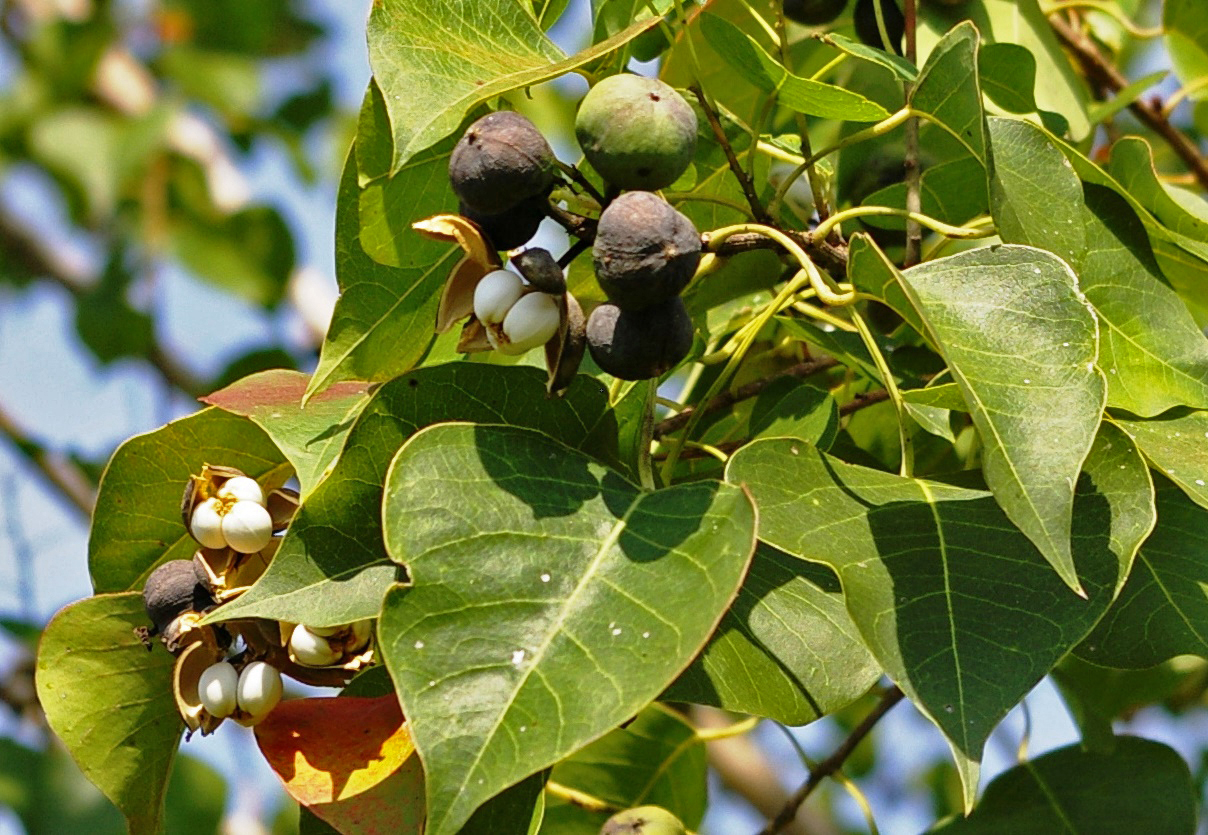Forestry & Wildlife

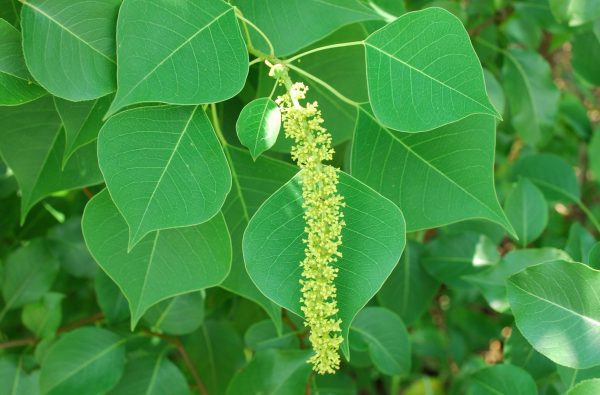
Chinese tallowtree has slender yellow floers that bloom during the early summer. The distinctive diamond-shaped leaves turn red in the fall.
The Chinese tallowtree, Triadica sebifera (L.) Small, is one of the most invasive trees in the southeastern United States. It is a classic example of a plant introduced into the United States with good intentions but with bad outcomes.
Benjamin Franklin is often cited as having introduced the tallowtree into the United States in 1772. Still, the species has been repeatedly promoted over the past 100 years for numerous purposes, including in the soap industry, as an ornamental shade tree, for honey production, and, most recently, for bioenergy. Chinese tallowtree is an ecosystem transformer with tremendous negative impacts on wetlands, pastures, prairies, and forests. In almost all these areas, tallowtree invasion frequently results in a closed canopy tallowtree forest with few other species present.
Multiple Factors Can Make Tallowtree Management Difficult
Multiple factors can make tallowtree management difficult. It produces large numbers of fruits, which are spread by water and consumed and spread by many species of birds. Bottomlands subject to periodic flooding may be repeatedly reinfested from upstream seed sources. Tallowtree is also an aggressive sprouter that rapidly regenerates from both stumps and lateral roots, so mechanical control methods frequently exacerbate the problem.
The following recommendations for several control techniques that can be used for tallowtree across various environments. Some discussion of techniques that do not work is also provided. Not all techniques work in all situations, and tallowtrees frequently grow along the water in difficult places.
Physical Removal
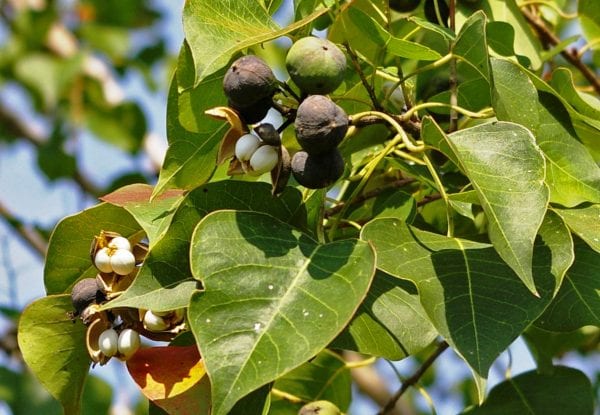
Also known as popcorn tree, Chinese tallowtree produces large numbers of waxy coated seeds that resemble popcorn. Seeds remain on the tree through early winter.
Seedlings may be pulled when very small. But hand pulling is not generally an practical option for controlling established tallowtree. Tallowtree rapidly establishes a deep taproot, making saplings challenging to remove, especially in heavier textured soils. The use of a weed wrench may help remove small saplings. However, stems originating from lateral roots will break off just below the soil surface, and new sprouts will form near the breakpoint. The use of bulldozers and excavators may be effective in removing entire trees and stumps. However, many lateral roots will be missed during removal, and sprouting can rapidly occur from these pieces. Many land managers have reported rapid increases in the density of tallowtree stands following removal with heavy equipment.
Mowing, Cutting, and Brush Mulching
In pastures, annual mowing has been used to suppress Chinese tallowtree, but it can worsen the problem. Because tallowtree rapidly sprouts from the stump and lateral roots, stem densities may increase over time with repeated mowing. Brush mulchers or shredders are effective in opening dense tallow stands and can be an excellent first step in tallowtree management. However, follow-up herbicide treatments are necessary for adequate control. If cutting tallowtree with a chainsaw, immediately apply a recommended herbicide to the freshly cut stump to prevent sprouting (see the following section on chemical control).
Prescribed Fire
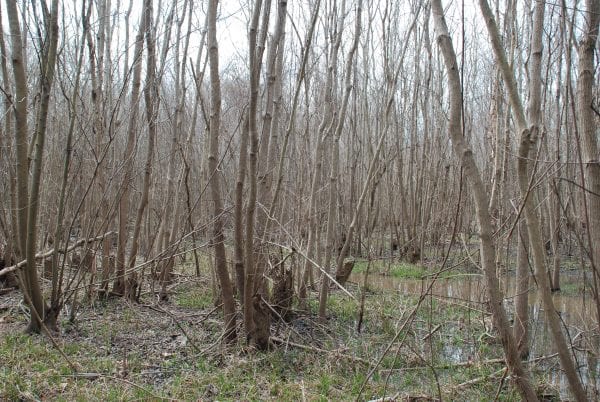
Dense stands of tallowtree are especially common near rivers. Note that many of the stems are from stump sprouts.
Prescribed fire typically is not effective for Chinese tallowtree control but might be useful as part of an integrated pest management approach. Sufficient fuel to carry fire is often lacking in pure stands or wet sites. In situations with enough fuel to carry a fire, prescribed fire may knock plants back but is not likely to provide complete control. Seedlings and small-diameter saplings are susceptible to fire, but larger diameter plants, even if top-killed, will generally sprout back following fire, and follow-up herbicide treatment will be needed.
Under some conditions, fire can promote the growth of tallowtree seedlings by clearing away competing vegetation and enhancing seed germination. As seedlings can be knocked back with prescribed fire, frequent prescribed fires (short return interval) may limit successful seedling establishment and help deplete the seed bank. Infrequent fires, though, could favor Chinese tallowtree establishment. The relationship between fire and Chinese tallowtree is complicated, depending on the fire intensity, fire return interval, and on-site and stand characteristics.
Biological Control
Grazing is usually not an option for Chinese tallowtree control. Although cattle will readily graze some other invasive plants such as kudzu and Chinese privet, they do not graze Chinese tallowtree at all. Goats will graze Chinese tallowtree, but they do not prefer it. Effective management would require numerously repeated grazing events by goats.
United States Department of Agriculture (USDA) research has identified two insects, a moth (Gadirtha fusca) and a flea beetle (Bikasha collaris), that show tremendous promise for classical biocontrol of Chinese tallowtree. They have not yet been approved for release.
Chemical Control
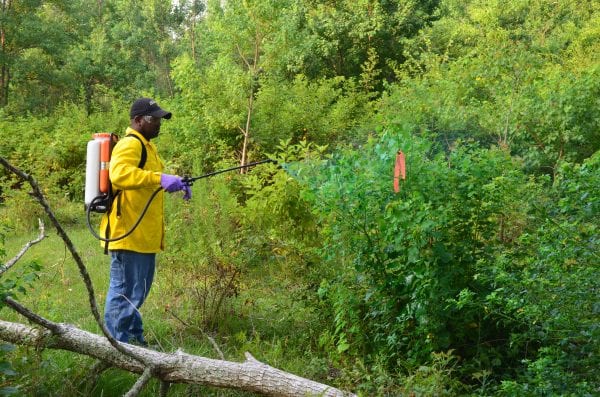
A blue spray indicator or dye improves spray visibility for the applicator. (Photo credit: Doug Streett, USDA Forest Service, Pineville, Louisiana)
Several herbicides may be used for effective Chinese tallowtree control (see table 1). As with any treatment method, there are no silver bullets and most herbicides will require multiple applications for complete kill. It is also important to remember that Chinese tallowtree frequently grows near water or where there is a shallow water table. This may preclude or limit the use of certain herbicides. Additionally, several herbicides in table 1 may cause injury or death to surrounding vegetation. Always read and follow the herbicide label for specific information concerning applications near water and nontarget injury. The herbicides in table 1 have been effective for various application methods, including broadcast, foliar individual plant treatment (IPT), basal bark, cut stump, and hack and squirt.
Table 1. Herbicide Treatments Recommended for Chinese Tallowtree Control (a)
b IPT = individual plant treatment. This term is used to distinguish herbicide rate recommendations on a percentage basis rather than on a per-acre basis.
| Herbicide | Example Trade Name(s) | Application Method | Rate | Site |
|---|---|---|---|---|
| Aminopyralid | Milestone | Cut stump | 10% | Noncrop, natural areas |
| Aminocyclopyrachlor + metsulfuron | Streamline | Broadcast IPT foliarb | 11.5 oz./A. | Noncrop, natural areas |
| 11.5 oz./100 gal. | ||||
| IPT Foliar | 2% | |||
| Cut stump | 50% | |||
| Imazamox | Clearcast | Broadcast | 64 oz./A. | Noncrop, aquatic, natural areas |
| Hack and squirt | 50% | |||
| Imazapyr | Arsenal, Habitat | Broadcast | 2 to 4 pt./A. | Noncrop, aquatic, forestry, natural areas |
| IPT Foliar | 2% | |||
| Cut stump | 6 to 9% | |||
| Hack and squirt | 50% | |||
| Picloram + fluroxypyr | Surmount | Broadcast | 3 to 6 pt./A. | Grass pastures |
| Picloram + 2,4-D | Grazon P+D | Broadcast | 4 qt./A. | Grass pastures |
| IPT foliar | 1% | |||
| Triclopyr amine | Garlon 3A, Renovate | IPT foliar | 2% | Noncrop, aquatic, natural areas, forestry |
| Triclopyr ester | Garlon 4, Pathfinder II | Basal bark | 20 to 30% | Noncrop, forestry, natural areas |
| Cut stump | 25% |
Additional Notes on Chemical Control
Foliar broadcast and individual plant treatments are most effective when applied from late summer to early fall. Do not apply foliar treatments after leaves begin changing color in the fall. Cut-stump treatments are easiest and most effective when applied in the late fall and can be used on any diameter stump. Always apply the herbicide immediately after cutting for water-based cut-stump treatments, such as aminopyralid, imazamox, or triclopyr amine. Basal bark and hack and squirt treatments are also most effective when used in the fall. Although, hack and squirt treatments with imazapyr or aminocyclopyrachlor have provided successful control when applied in any of the four seasons. Basal bark treatments are effective on trees less than 6 inches in diameter at the base. Hack and squirt treatments are effective on any size trees. A common practice is to make one incision for every 3 inches of stem diameter at breast height (DBH). Avoid treatment in the spring when sap flow is upward and new leaves are forming for all application methods.
 Nancy Loewenstein, Extension Specialist, Forestry, Wildlife and Environment; David Russell, Assistant Extension Professor, Crop, Soil, and Environmental Sciences; and Stephen Enloe, former Extension Specialist, all with Auburn University
Nancy Loewenstein, Extension Specialist, Forestry, Wildlife and Environment; David Russell, Assistant Extension Professor, Crop, Soil, and Environmental Sciences; and Stephen Enloe, former Extension Specialist, all with Auburn University
Revised July 2022, Management Options for Chinese Tallowtree, ANR-2232

